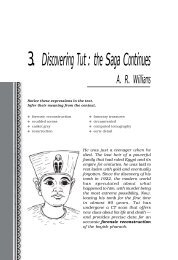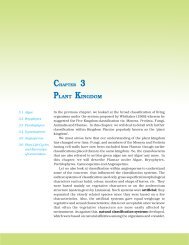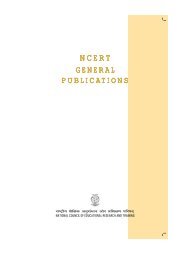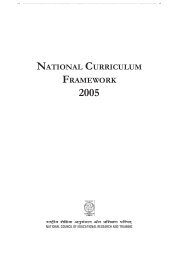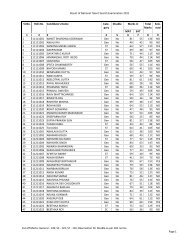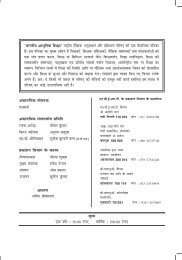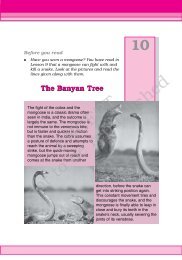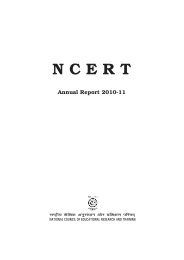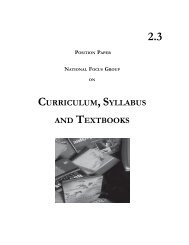indian education - National Council Of Educational Research And ...
indian education - National Council Of Educational Research And ...
indian education - National Council Of Educational Research And ...
You also want an ePaper? Increase the reach of your titles
YUMPU automatically turns print PDFs into web optimized ePapers that Google loves.
34 Journal of Indian Education August 2007<br />
scattered hills, on the edge of the Mysore<br />
Plateau, he located the landscape where<br />
he hoped to lay the foundations of the<br />
‘religio-scholastic atmosphere’ he had<br />
not found in California. The place was<br />
dry scrubland prone to drought, even<br />
famine, inhabited by stonecutters,<br />
shepherds and cattle farmers.<br />
Sacred shrines built by these ancient<br />
people stood scattered all over the valley.<br />
Under the shade of neem trees, four thin<br />
slabs of stone not more than a foot high<br />
are arranged to form a rectangular space<br />
that encloses mother goddess stones; the<br />
goddess is propitiated with blood<br />
sacrifice of cocks and, during prolonged<br />
droughts, with goats.<br />
The goddess Gangamma has a larger<br />
whitewashed temple. The majestic neem<br />
tree under which it stood was destroyed<br />
by a storm a few years ago and replaced<br />
by a Durga seated on a lion. Her stepwell,<br />
so beautifully lined with dressed<br />
stones, remains dry throughout the year.<br />
A classical temple to Krishna situated<br />
in the only traditional village Thettu gives<br />
the valley a hint of classical antiquity. It<br />
was not the temple, however, that drew<br />
Krishnamurti to Thettu Valley, but a<br />
three-hundred-year-old Banyan tree,<br />
which dominated the stark scene and the<br />
wooded hills that stood like sentinels at<br />
the western end of the valley. The<br />
disjunction between the primeval Thettu<br />
landscape from the urban vitality of a<br />
great university in the New World could<br />
not have been more complete.<br />
In the 70 years, since the land was<br />
acquired for the school, the landscape<br />
has changed. The track that encircles<br />
the valley, where shepherds drove their<br />
flock of sheep and goat to distant forests,<br />
is now broader. It is still used by<br />
herdsmen, descendants of the same<br />
people, but also by rattling lorries and<br />
buses. A part of this road is paved. There<br />
is a small row of peepal trees on either<br />
side of the road, but the virgin forests on<br />
the hills are slowly disappearing; during<br />
the summer months goatherds trim<br />
these trees for their flock; local women<br />
have to walk long distances for fuel.<br />
There are many bore wells belonging to<br />
the school and the more prosperous<br />
landowners. The school and its urban<br />
population now dominate the valley. The<br />
Valley telescopes time, modernity mingles<br />
with many layers of tradition. As we shall<br />
see it represents in miniature the<br />
layering of cultures, which is a hallmark<br />
of social development in the past.<br />
D. D. Kosambi, that doyen of Indian<br />
historians, more than fifty years ago<br />
observed that the telescoping of time, in<br />
other words, the contemporaneous<br />
existence of many stages of human<br />
development from the past is a general<br />
but unique feature of India’s history.<br />
According to Kosambi, India is a country<br />
of “long survivals”: ‘People of the atomic<br />
age rub elbows with those of the<br />
chalcolithic,’ he observed as he travelled<br />
on the Deccan Queen in the early fifties<br />
from his home in Pune to the Tata<br />
Institute of Fundamental <strong>Research</strong> in<br />
Bombay, (now Mumbai) and went on to<br />
prove that the ancient Buddhist caves<br />
along the Western Ghats followed the<br />
migratory patterns set out by older<br />
generations of Neolithic tribesmen.<br />
The school established in 1931,<br />
consisted of English-speaking, feepaying<br />
students from India’s successful<br />
middle classes. Gordon Pierce, the<br />
principal of Rishi Valley and founder of<br />
the Public School Movement in India,




